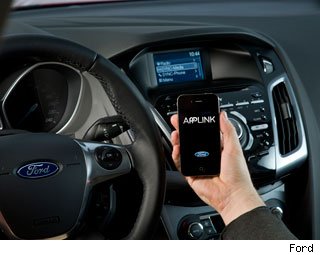The Five Technologies You Must Understand Before You Buy Your Next Car

-

- Image Credit: Ford
Cars often come loaded with technology that many people don’t know or understand.
My father-in-law drove a Chrysler Town & Country for years never knowing that he could flip one switch and heat up his seat. He had paid for this feature, but never even knew it was available.
Nowadays, it’s even more complex as emerging technologies are quickly making their way into vehicles and consumers don’t know what they are or how to use them. Some they may like, others they may not care for.
But if you’re shopping for a car, truck or SUV nowadays, you’d better know what you’re paying for. Some of it could save your life.
Click through to see some of the most important technology in many vehicles and why you should know what it does before you buy. -
- Image Credit: VW
Adaptive Cruise Control
What It Is: An automatic cruise control system that will adjust the car’s speed based on the speed of the car in front of it.
Why It's Important: Adaptive cruise control is quickly becoming a popular feature on many different vehicles. For someone who does lots of highway driving, it’s a feature you’ll quickly learn to love.
Maintaining a constant speed will improve a car’s fuel economy, and monitoring the car’s position relative to other vehicles will help keep the driver safer. -
- Image Credit: Ford
Voice Recognition
What It Is: A program in the car that uses the person’s voice commands to operate different features in the car ranging from finding a song on an iPod to adjust the air conditioner.
Why It's Important: Keeping your hands on the wheel is a key to good driving. Operating switches and knobs and buttons by voice allows any driver to keep both hands on the wheel even more often. Furthermore, if a car has voice recognition software, it will also have the means to speak on your phone hands free. Ten states require all drivers to use a hands free device when operating a cell phone and more states are expected to pass similar laws.
However, it’s essential to learn how to use your voice recognition software correctly. Some systems require specific commands in order to properly connect with the car’s computer. These systems can become frustrating if you don’t take the time to learn how it works. -
- Image Credit: Volvo
Collision Avoidance
What It Is: Collision avoidance generally starts with a system called adaptive cruise control. This is like regular cruise control, but with the addition of radar sensors that can "see" the traffic ahead of you and slow your car to maintain a safe following distance. If you are a notorious tailgater, this system over-rides your own bad driving habits. Collision avoidance systems can also sound alarms or flash warnings on the windshield if the sensors determine that your car is getting too close to another car too fast. The system will then apply brake pressure perhaps sooner than you yourself would.
Why It's Important: You have to be aware of any system that is going to apply braking pressure without your foot doing the work. The system may come as part of a broader "safety package" that you buy on either a new or used, so its imperative that you understand how it works. This system could save your life, or at minimum keep you from a parking lot fender bender.
Check out our longer "Techsplanation" on "Collision Avoidance" systems here. -
- Image Credit: Mercedes-Benz
Blind Spot Detection
What It Is: A system of cameras or radars that detect vehicles in the driver’s blind spots. The system then will then let the driver know there’s a vehicle in his blind spot. Often, if the driver attempts to move into the lane another car is, the system will provide an audible warning to stop.
Why It's Important: While carmakers offer different versions of this system, every one I have ever tested works very well. It quickly lets you know that someone is in your blind spot and, if you try to move over, it warns you.
It takes only a few days of highway driving to get used to a blind spot detection system. You’ll quickly find yourself glancing in your mirrors to see if there’s anyone there and you’ll begin trusting the system more and more.
Just be careful when you drive someone else’s car without the system. -
- Image Credit: GM
Extended-Range Electric Vehicles
What It Is: A car that runs on battery power for a short distance, say between 10 and 35 miles, but also contains a gasoline-fed motor that continues to power the battery when the charge is depleted. The new extended-range EVs include the Chevy Volt, Ford C-Max Energi, Prius Plug-In Hybrid and Fisker Karma.
Why It's Important: There is an argument to be made that an extended-range plug-in is the perfect technology to get U.S. drivers to the point where they can routinely choose between gasoline and electric power for their fuel stock. These combination vehicles eliminate "range anxiety," which is the fear of driving an EV and fearing you will rin out of power before you have time or opportunity to recharge.
Most Americans drive fewer than 40 miles per day, so vehicles like the Volt (35 miles on a charge) or C-Max (20 miles on a charge) make a lot of sense.
Check out our longer "Techsplanation" on owning electric vehicles here.




